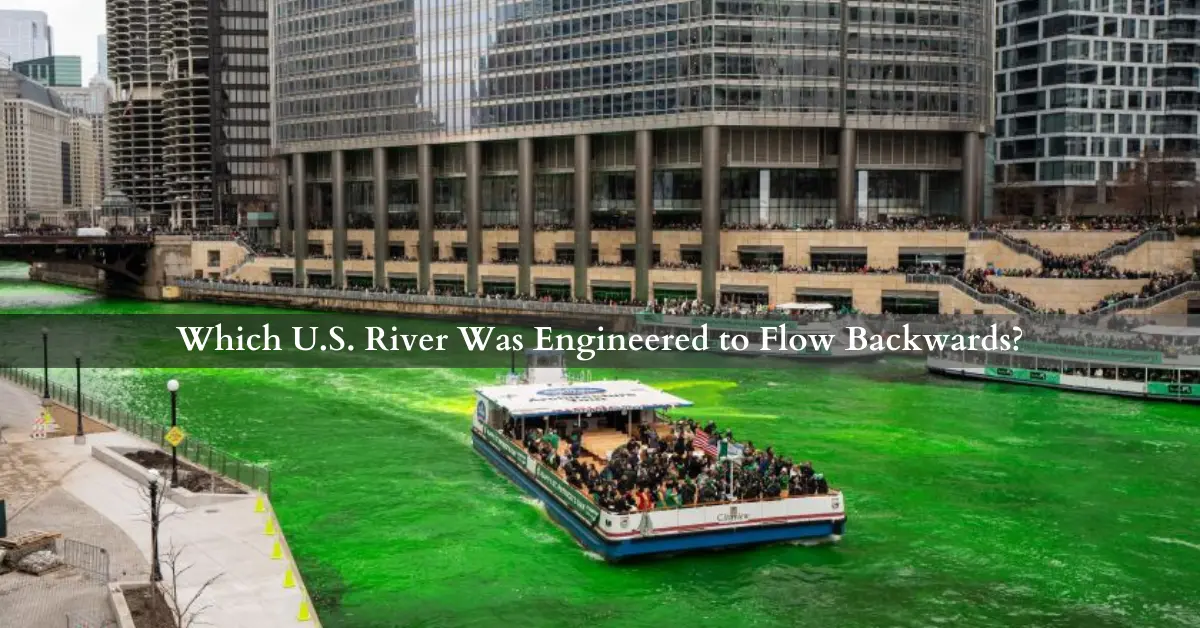
Which U.S. River Was Engineered to Flow Backwards?
In the annals of engineering history, few feats stand as remarkable as the reversal of the flow of a mighty river. Yet, in the heart of the United States, nestled within the bustling metropolis of Chicago, lies a testament to human ingenuity and determination—the Chicago River, once engineered to flow backwards.
This remarkable transformation, undertaken in the late 19th and early 20th centuries, reshaped the landscape and trajectory of urban development, forever altering the course of one of America’s most iconic waterways.
Why does the Chicago River flow backwards? I Historyfeels
The Chicago River has long been a vital artery for the city, providing a crucial transportation route and a source of water for industry and commerce. However, by the mid-19th century, the river had become heavily polluted, choked with sewage and industrial waste. The prevalence of waterborne diseases and the foul stench emanating from its waters cast a shadow over the burgeoning city’s prospects for growth and prosperity.
The solution to this pressing problem lay in a bold and ambitious plan: to reverse the flow of the Chicago River. Spearheaded by civil engineer and visionary thinker, Ellis S. Chesbrough, this audacious undertaking aimed to divert the river’s flow away from Lake Michigan, thereby preventing the contamination of the city’s primary source of freshwater.
Also read: What is Protecting Americans from Foreign Adversary Controlled Applications Act? What is H.R.7521?
The plan involved the construction of an intricate network of canals and locks, designed to channel the flow of water away from Lake Michigan and towards the Illinois River, ultimately leading to the Mississippi River and the Gulf of Mexico. At the heart of this system lay the Chicago Sanitary and Ship Canal, a monumental engineering feat stretching over 28 miles, connecting the Chicago River to the Des Plaines River and effectively reversing its flow.
Construction of the canal began in 1892 and required Herculean efforts, employing thousands of laborers and engineers who toiled tirelessly to excavate the earth, lay concrete, and erect the necessary infrastructure. The project faced numerous challenges, including engineering obstacles, financial constraints, and political opposition.
However, through perseverance and determination, the visionaries behind the endeavor overcame these hurdles, and on January 2, 1900, the waters of the Chicago River were officially reversed.
The impact of this monumental achievement was immediate and profound. By diverting the polluted waters of the Chicago River away from Lake Michigan, the city safeguarded its primary source of drinking water, protecting the health and well-being of its citizens.
Moreover, the reversal of the river’s flow facilitated the expansion of commerce and industry, as ships could now navigate more easily between the Great Lakes and the Mississippi River, opening up new markets and opportunities for trade.
The transformation of the Chicago River also had far-reaching ecological consequences, reshaping the landscape and habitat of the region. The reversal of the river’s flow altered the natural drainage patterns of the area, leading to the depletion of wetlands and the disruption of aquatic ecosystems.
Additionally, the influx of nutrient-rich water from Lake Michigan into the Chicago River contributed to the proliferation of invasive species, further exacerbating ecological imbalances.
Despite these unintended consequences, the reversal of the Chicago River remains a testament to human innovation and resourcefulness. It stands as a symbol of the transformative power of engineering and the indomitable spirit of those who dare to dream big and challenge the status quo.
Today, as the city of Chicago continues to evolve and thrive, the legacy of the reversed river serves as a reminder of the enduring legacy of those who dared to defy convention and reshape the world around them.
In conclusion, the reversal of the Chicago River stands as one of the most remarkable engineering achievements in American history. Through visionary planning, unwavering determination, and sheer hard work, engineers and laborers transformed a polluted waterway into a vital artery for commerce and industry.
While the project had its share of challenges and unintended consequences, its lasting impact on the city of Chicago and the surrounding region is undeniable. As we look to the future, the story of the reversed river serves as both an inspiration and a cautionary tale, reminding us of the power of human ingenuity to shape our world for better or for worse.
FAQs
1. Why was the Chicago River reversed?
The Chicago River was reversed to prevent the contamination of Lake Michigan, the city’s primary source of freshwater, due to pollution from sewage and industrial waste.
2. How was the Chicago River reversed?
The reversal was achieved through the construction of the Chicago Sanitary and Ship Canal, an extensive network of canals and locks that diverted the flow of the river away from Lake Michigan and towards the Illinois River.
3. When was the Chicago River reversed?
The reversal of the Chicago River was completed on January 2, 1900, after years of planning and construction efforts.
4. What were the consequences of reversing the Chicago River?
The reversal had immediate benefits, such as safeguarding the city’s water supply and facilitating trade. However, it also led to ecological changes, including disruptions to natural drainage patterns and the proliferation of invasive species.
5. Who was involved in the reversal of the Chicago River?
Civil engineer Ellis S. Chesbrough played a pivotal role in planning the reversal, along with numerous laborers, engineers, and government officials who contributed to the construction and implementation of the project.
Content Contributor: Juhi Saluja









